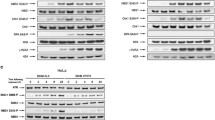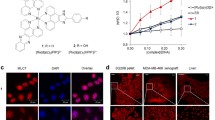Abstract
Several new complexes of platinum with positively charged cellular dyes have been synthesised in an effort to find chemotherapeutic drugs with increased antitumour cytotoxicity. As part of this effort, the direct cytotoxicities of some of these complexes as well as their ability to inhibit bleomycin potentially lethal damage repair (PLDR) was studied in vitro in a squamous cancer cell line of human origin (SCC-25). All of the new agents were more cytotoxic against exponentially growing than against plateau phase cell cultures. Exposure of cells to non-lethal drug concentrations for between 1 and 6 h led to measurable inhibition of bleomycin PLDR in the case of each drug tested. In order of decreasing ability to inhibit bleomycin PLDR, Pt(fast black)2, Pt(thioflavin)2 and Pt(thionin)2 were more effective than CDDP, while Pt(methylene blue)2, Pt(Rh-123)2 and Pt(pyronin Y)2 were less effective. The most directly cytotoxic agents were Pt(thioflavin)2, Pt(pyronin Y)2 and Pt(Rh-123)2 which also proved to be the least selectively toxic drugs towards exponential versus plateau phase cells. These results indicate that several of the new platinum complexes may be effective cytotoxic agents as well as effective inhibitors of DNA repair process following exposure of cells to other DNA interactive modalities.
Similar content being viewed by others
Author information
Authors and Affiliations
Rights and permissions
About this article
Cite this article
Wang, Y., Herman, T. & Teicher, B. Platinum-dye complexes inhibit repair of potentially lethal damage following bleomycin treatment. Br J Cancer 59, 722–726 (1989). https://doi.org/10.1038/bjc.1989.152
Issue Date:
DOI: https://doi.org/10.1038/bjc.1989.152
- Springer Nature Limited
This article is cited by
-
Interaction of platinum complexes of thiazin and xanthene dyes with hyperthermia
Cancer Chemotherapy and Pharmacology (1990)




